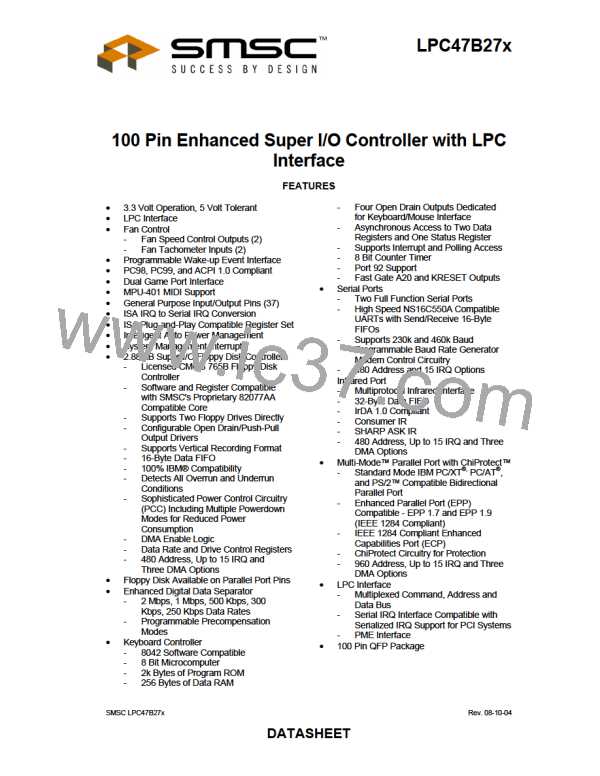POWER MANAGEMENT
Power management capabilities are provided for the following logical devices: floppy disk, UART 1, UART
2 and the parallel port. For each logical device, two types of power management are provided: direct
powerdown and auto powerdown.
FDC Power Management
Direct power management is controlled by CR22. Refer to CR22 for more information.
Auto Power Management is enabled by CR23-B0. When set, this bit allows FDC to enter powerdown
when all of the following conditions have been met:
1. The motor enable pins of register 3F2H are inactive (zero).
2. The part must be idle; MSR=80H and INT = 0 (INT may be high even if MSR = 80H due to polling
interrupts).
3. The head unload timer must have expired.
4. The Auto powerdown timer (10msec) must have timed out.
An internal timer is initiated as soon as the auto powerdown command is enabled. The part is then
powered down when all the conditions are met.
Disabling the auto powerdown mode cancels the timer and holds the FDC block out of auto powerdown.
Note: At least 8us delay should be added when exiting FDC Auto Powerdown mode. If the
operating environment is such that this delay cannot be guaranteed, the auto powerdown mode
should not be used and Direct powerdown mode should be used instead. The Direct
powerdown mode requires at least 8us delay at 250K bits/sec configuration and 4us delay at
500K bits/sec. The delay should be added so that the internal microcontroller can prepare itself
to accept commands. See SMSC Application Note: Application Considerations When Using the
Powerdown Feature of SMSC Floppy Disk Controllers.
DSR From Powerdown
If DSR powerdown is used when the part is in auto powerdown, the DSR powerdown will override the auto
powerdown. However, when the part is awakened from DSR powerdown, the auto powerdown will once
again become effective.
Wake Up From Auto Powerdown
If the part enters the powerdown state through the auto powerdown mode, then the part can be awakened
by reset or by appropriate access to certain registers.
If a hardware or software reset is used then the part will go through the normal reset sequence. If the
access is through the selected registers, then the FDC resumes operation as though it was never in
powerdown. Besides activating the nPCI_RESET pin or one of the software reset bits in the DOR or DSR,
the following register accesses will wake up the part:
1. Enabling any one of the motor enable bits in the DOR register (reading the DOR does not awaken the
part).
2. A read from the MSR register.
3. A read or write to the Data register.
Once awake, the FDC will reinitiate the auto powerdown timer for 10 ms. The part will powerdown
again when all the powerdown conditions are satisfied.
Register Behavior
Table 48 illustrates the AT and PS/2 (including Model 30) configuration registers available and the type of
access permitted. In order to maintain software transparency, access to all the registers must be
maintained. As Table 49 shows, two sets of registers are distinguished based on whether their access
results in the part remaining in powerdown state or exiting it.
Access to all other registers is possible without awakening the part. These registers can be accessed
during powerdown without changing the status of the part. A read from these registers will reflect the true
status as shown in the register description in the FDC description. A write to the part will result in the part
SMSC LPC47B27x
- 94 -
Rev. 08-10-04
DATASHEET

 SMSC [ SMSC CORPORATION ]
SMSC [ SMSC CORPORATION ]